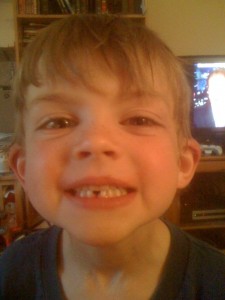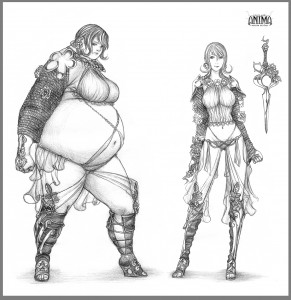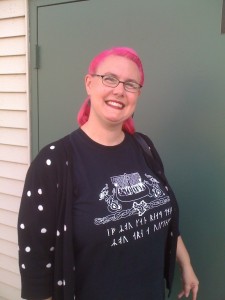I’m of two minds about shopping. I love seeing pretty, cool, interesting new things. Some of them, I even enjoy trying on or, if the stars are right, buying them. I also love seeing what Nightmares of Fashion Past are currently visiting themselves upon kids too young to have suffered them the first time.
On the other hand, we’re a lower-middle class, half-Aspergian family. We have young sons with voices that can shatter glass and the combined attention span of a brain-damaged goldfish. Big-box stores and malls not only stress the hell out of me, they often hurt me physically–cement floors are the bane of my existence.
And then there’s the fact that I’m fat. Clothes shopping is an exercise in frustration and self-loathing. Women’s sizes are frequently not available in stores, and when they are, those stores seem to think that plus-sized women are both color- and pattern-blind, and happy to spend another $10-15 for the same design in one size larger than the range they’ve decided is “normal.” My particular body shape further complicates things by being both tall and hourglass-shaped. Consequently, I’m forced to buy shirts a size bigger than I actually need them if I want them to button, and I’ve never once owned a pair of jeans that fit well at waist, hip, and length.

My boys at the Mall of America LEGO store last summer. The mech and helicopter behind them? Made of LEGO.
In any case, the underwire on my next-to-last bra broke suddenly this week, leaving me with one, count ’em, one bra to wear. This is not an Acceptable Situation. Since we’d already promised Connor he could pick out a new LEGO set as a reward for a week of good, steady progress in his program, and they didn’t have the Marvel Super Heroes LEGO at the local stores, we committed to making the pilgrimage to the Mall of America’s LEGO store. It’s pretty epic, and with a budget firmly established in advance, it’s a bunch of fun for all of us. I figured I’d make my own quick trip to Nordstrom, which is widely regarded as the best place to get fitted properly for a bra, and actually find one in irregular sizes like mine.
While the thought of a new bra or two appeals greatly, for practicality and pleasure, the thought of submitting to the handling and scrutiny of my gigantic bosom and scarred, lumpy midsection by a stranger with a measuring device appeals not at all. But I’d worked my heart and mind up to a place where I could tolerate the humiliation and inevitable revulsion I would face in that dressing room. I’d taken some Xanax to dull the psychic trauma of being in a place with so much ambient noise and stress. And I’d settled the boys comfortably, post-LEGO acquisition, so I wouldn’t have to take them into the highbrow hush of Nordstrom.
I went up to the the Lingerie section and spent a few minutes admiring both the lovely underthings and the signs that said “Sizes up to 44H.” A saleslady approached me and asked if she could help. I asked the general price range of their bras. She responded, “They go up to $200.” I nodded, more nonchalant than I felt, and asked again, “But the average price? Around $30 or 40?”
She laughed at me, a sniffy sound of disbelief. “Ah ha ha, um, no. They average around $60.” I thanked her for the information, and left with as much speed and dignity as I could muster.
Let me say that again: The Nordstrom saleswoman laughed at me.
I’d gone in there, ready to face shaming for my size and shape. I wasn’t ready to be shamed for my income before I’d even taken off a stitch of clothing. It was more than I could bear, and there were tears welling in the rim of my glasses before I even got back to the table where my boys were sitting. I didn’t trust myself to say out loud what had happened, so I typed it quickly on my phone so my Darling Husband would know: “Ever walk into a place and immediately feel like you’re not welcome, that you’re not good enough to be there and everyone knows it? She laughed at me when I asked if there were any bras in the $30 range.”
My sons saw the tears rolling silently down my face, and not knowing why, they still rose to press tiny, tight hugs around me. My Darling Husband, whom anyone who knows him is not quick to anger, got that tight set to his jaw, and walked silently into the store. When he came back, he told me he’d found the saleswoman and asked for her manager. The woman’s response to the confrontation was that she certainly hadn’t intended it that way; he informed her that, when the effect was so horrendous, her intentions weren’t worth a damn. We both worked in retail for a long time, coming up, so he knew precisely the right words to invoke. He told them both that, in humiliating his wife, they had both failed utterly at customer service and managed to permanently lose at least two customers.
But I was wrecked, and the only passive-aggressive revenge I could manage at the time was to tweet my grief and horror. And as I told the friends on Twitter and Facebook who immediately rallied to me and suggested both solutions and unspeakable tortures upon the saleswoman, if I could find a bra as supportive as all those wonderful people, I’d be set for life. It wasn’t until today that I realized I have a teeny tiny platform of my own.
So let me say this. The difference between the haves and the have-nots has rarely been greater in this country. This divide isn’t just social or economic–it’s also geographic. There are places where people who don’t have much money are not only not welcomed, but where they will be humiliated for even daring to darken the doorstep. Don’t even breathe on the merchandise–your poorness might be catching, and we wouldn’t want that. I’ve already learned that, the fewer pieces of merchandise in a store, the less likely it is someone like me could afford anything in there. And if there are no price tags, don’t even bother asking–it’s out of your range.
The people who staff these places make snap judgments on the fitness of a patron in a split second, on purely superficial impressions, the very least reliable kind. That scene from Pretty Woman? It doesn’t only happen on Rodeo Drive. Apparently it happens in a Minnesota department store, too.
Want to know the saddest thing? Nordstrom has a discount sister store, Nordstrom Rack. I’ve bought clothes with retail prices in the hundreds of dollars for $20 or less at Nordstrom Rack. There is even, in fact, a Nordstrom Rack in the Mall of America (something I didn’t know yesterday). If that saleswoman was serious about the customer service reputation and/or the bottom line of Nordstrom, Inc., she could have easily directed me to that location for bras in my price range, and I would’ve left a happy customer likely to spend my hard-earned money on their merchandise. I might even have tweeted how pleased I was by the service I’d received.
But she didn’t. So I left her workplace feeling like dirt for daring to step outside Walmart with my grubby, contagious, working-class, overweight self.
So here’s what I have to say. Even if you’ve got the money to spend at Nordstrom–maybe even especially if you do–don’t. Unless you like that atmosphere that judges people, that says there’s a different America for those who don’t look right or make their money the right way. Give your money to the places that wait to see that your money’s as green as anyone else’s, or better yet, the ones that see a person first, instead of a class.
 Physical Ed, Political Science
Physical Ed, Political Science  1 Comment
1 Comment  This is Griffin. He turned six in April. You can see that he just lost his first tooth. I don’t write about him as much as his older brother, but that’s my failing, not his. He’s weird, he’s wonderful, he’s so adorable it makes me spit.
This is Griffin. He turned six in April. You can see that he just lost his first tooth. I don’t write about him as much as his older brother, but that’s my failing, not his. He’s weird, he’s wonderful, he’s so adorable it makes me spit.

 And the culture finds all sorts of ways to remind plus-size women that they’re less than. Affordable plus-size clothes are made of cheap fabrics and rejected patterns that would never be found in the juniors or misses racks. It gets even worse if you need maternity clothes. Sure, companies like
And the culture finds all sorts of ways to remind plus-size women that they’re less than. Affordable plus-size clothes are made of cheap fabrics and rejected patterns that would never be found in the juniors or misses racks. It gets even worse if you need maternity clothes. Sure, companies like 
 I saw my psychiatrist the other day for my regular check-in. As we went over the list of meds I’m taking, both those prescribed by him and those from other doctors, I said that the anti-depressant I’m on right now is working just fine, and that the only real change since I last saw him was that my pain management docs were having me transition from narcotic pain relievers for my fibromyalgia onto tramadol, a non-narcotic.
I saw my psychiatrist the other day for my regular check-in. As we went over the list of meds I’m taking, both those prescribed by him and those from other doctors, I said that the anti-depressant I’m on right now is working just fine, and that the only real change since I last saw him was that my pain management docs were having me transition from narcotic pain relievers for my fibromyalgia onto tramadol, a non-narcotic.
